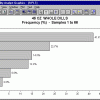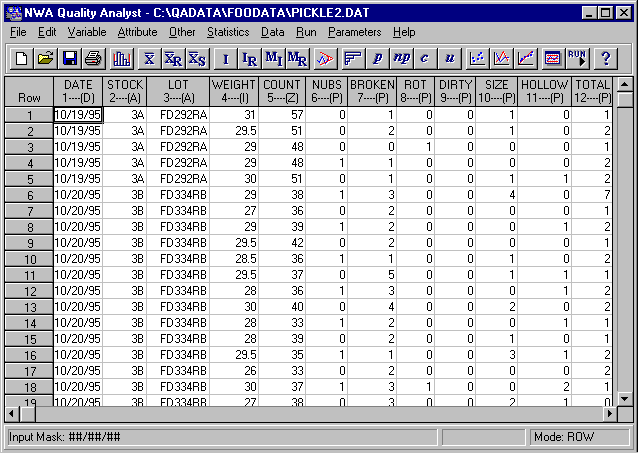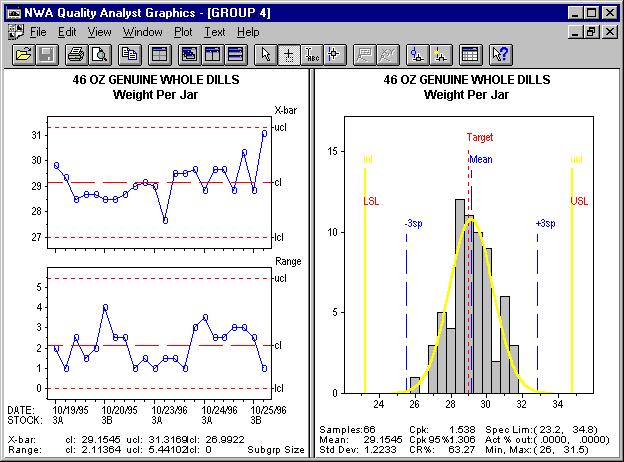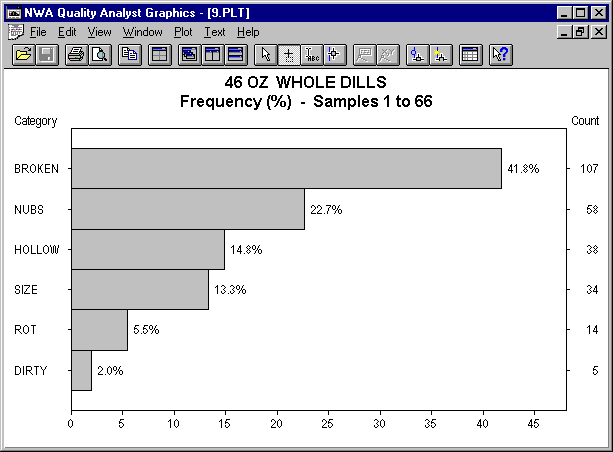Statistical process control is a necessary part of modern food processing. The software chosen to satisfy basic food processing SPC needs will determine whether SPC is an awkward, intrusive task or a smoothly operating part of the process. It must not only collect quality data and produce control charts, but also provide those additional capabilities and analysis which make it the core of a well run and effective quality and process management system.
The successful implementation of Statistical Process Control (SPC) begins with the selection of the tools and methods best suited to the company's quality goals. Because manual charting can be burdensome and time-consuming, PC-based SPC using specialized software is preferable for routine charting and essential for process improvement studies.
Numerous PC-based SPC software packages are readily available. Most, however, were created for discrete manufacturing such as auto parts machining, and consequently are limited in their application for other manufacturers. Food processors evaluating SPC software need to be aware of these shortcomings when making their selection:
- Limited usability
Can the software handle both process and laboratory data? Is the software able to present critical process data in a way that is effective for each users role in the organization? Will you be able to select one package to meet the needs of all users? - Data limitations
Can descriptive, measurement, and defect data be viewed in and analyzed from the same data file? - Operator requirements
Can routine charting tasks be automated to reduce training time? Is unattended operation possible? - Rigidity
Can charts be configured to precisely meet internal Quality Control (QC) needs and still meet customer and regulatory reporting requirements? - Data isolation
Can the software easily collect process data? Can it accept instrument data? Can it share or exchange data with corporate or plantwide information systems? Can it easily deliver analytical results and reports to users throughout the organization? - Vendor awareness
Are the software developers knowledgeable about the issues and special requirements of the food processing industry?
With the introduction of NWA Quality Analyst in 1985, Northwest Analytical, Inc. (NWA) made the needs of the food processing industry a special focus. Because NWA's development staff understands the needs and challenges faced in implementing SPC in the industry, NWA Quality Analyst is now the leading SPC software for food processors. Today, NWA Quality Analyst is used by small independents as well as major multinationals. Their applications range from internal QC and process improvement to vendor certification and regulatory compliance.
Case Study—Pickle Quality Control and Process Analysis
A large regional food processor uses NWA Quality Analyst (Quality Analyst) to monitor quality in their dill pickle packing line. Finished jars of pickles are pulled from the production line for routine data collection and charting. Samples are then drained, weighed, and inspected for defects. Description variables and data as shown below are entered into a Quality Analyst data set. The description variables are used to label routine SPC charts and provide easy reference points for later process improvement studies.
Description Variables
- Date: Sampling date
- Stock: Pickle size being packed
- Lot: Lot code
Measurement Variables
- Weight: Drained weight of pickles
Defects and Counts
- Count: Number of pickles per jar
- Nubs: Nubs, crooks, misshapen
- Broken: Broken, mechanical damage
- Rot: Rot, shriveled
- Dirty: Dirty, scarred
- Size: Incorrect Sizing
- Hollow: Hollow
Note that all the above information is collected at the same time and entered into a single Quality Analyst data set. (See Figure 1.) Charting can then be launched from the data entry screen with push-button ease. In fact, those abilities were significant factors in the processor’s selection of NWA Quality Analyst.
Putting SPC to work
The full value of Quality Analyst became apparent when the company considered alternate solutions to a potential supply shortage. The company’s SOP (Standard Operating Procedure) for its 46-ounce (filled weight) jar required a "3A" pickle size (1-1/8 in. to 1-1/4 in.) When supplies ran low, the limitation forced a choice between buying more expensive 3A pickles on the open market or changing the SOP to allow use of another stock size, "3B," 1-1/4 in. to 1-3/8 in. If the weight specification could be maintained, the alternate size would be acceptable. To find out, the company made a trial run using 3Bs. Once again, all data needed to analyze 3A and 3B stock could be entered into a single data set.
The apparent success or failure of using 3B stock would be indicated in a process capability histogram, a chart showing the distribution of pickle weights and their relationship to specifications. First, however, the weights must be analyzed using a control chart to verify the packing process was in statistical control. As Figure 2 shows, Quality Analyst allows users to display histograms and control charts simultaneously. The X-bar and Range chart show the packing process to be in statistical control for both stocks, thus validating the process capability study.
Labeling regulations allow up to 20 percent variation from the target. The Cpk index, a commonly used numeric representation of the capability of a process, shows both stocks meet production requirements. However, process capability doesn't always tell the whole story. Another view of the data suggests further analysis is in order.
Because the most commonly used statistical charting techniques can all be launched from a tool bar above the data entry screen, NWA Quality Analyst allows users to easily examine their processes from a variety of perspectives. A routine review of defects using Pareto analysis finds that the defect "broken" had increased during the test run. (See Figure 3.)
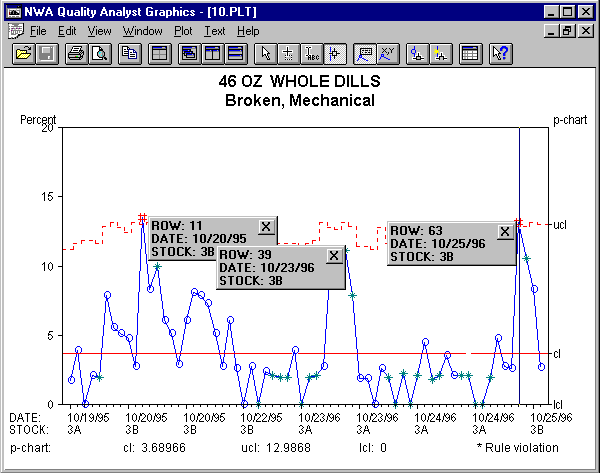 For further analysis, the lab produces a p-chart (percent defective SPC chart) (see Figure 4) and finds two points above the upper control limit. Pattern rule violations, shown on the chart by asterisks, provide further warning. The operator then clicks on each suspect data point to "drill down" for more information. The resulting dialogue boxes point to the 3B stock. Using Quality Analyst's unique Data Filter, separate p-charts for each stock type quickly confirm 3B stock as the source of the unacceptable levels of breakage. (See Figure 5.)
For further analysis, the lab produces a p-chart (percent defective SPC chart) (see Figure 4) and finds two points above the upper control limit. Pattern rule violations, shown on the chart by asterisks, provide further warning. The operator then clicks on each suspect data point to "drill down" for more information. The resulting dialogue boxes point to the 3B stock. Using Quality Analyst's unique Data Filter, separate p-charts for each stock type quickly confirm 3B stock as the source of the unacceptable levels of breakage. (See Figure 5.)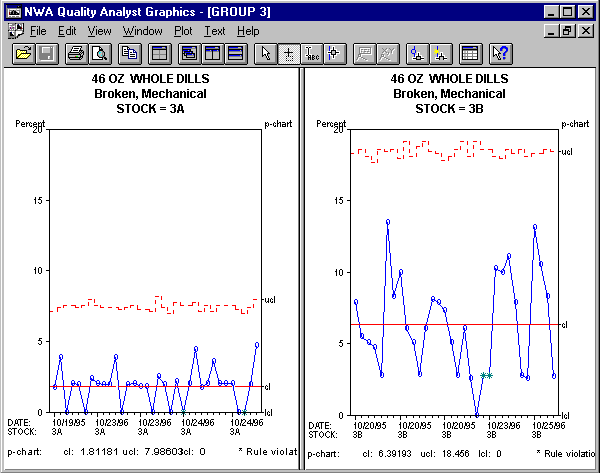
Further study reveals that 3B pickles frequently must be forced into the jar, causing breakage. However, the p-chart shows the process itself to be in statistical control - breakage is a natural part of the process. The processors conclude that while the 3B stock could be used to remain in label weight compliance, breakage may be excessive.
Conclusions Reached
The SPC analysis leads the processors to three key conclusions about their process:
- They can maintain statistical control and process capability while using either or both pickle stocks.
- Excessive broken pickles result when using the larger 3B stock.
- SPC analysis of broken pickles for the 3B stock shows it to be in perfect statistical control; this means the higher breakage rate is characteristic of the process and not due to any "special cause."
By having a clear understanding of their packing process, the company recognizes three distinct choices:
- Live with the breakage and risk customer displeasure.
- Continue to study the process to determine if the process can be modified to reduce 3B breakage in a cost-effective manner.
- Meet shortages by continuing to purchasing 3A stock on the open market.
NWA Quality Analyst delivered valuable analytics to all levels of the organization helping both managers and production staff to understand their processes and enabling them make confident decisions which impacted both product quality and costs.
Application-Specific Charts
NWA Quality Analyst also produces many special purpose charts that apply to the food processing industry. Two examples are Cumulative Sum (CUSUM) and Median/Individual Measurements (M/I) control charting. These procedures were included in the software to meet customers' needs for exact solutions.
CUSUM and Regulatory Requirements
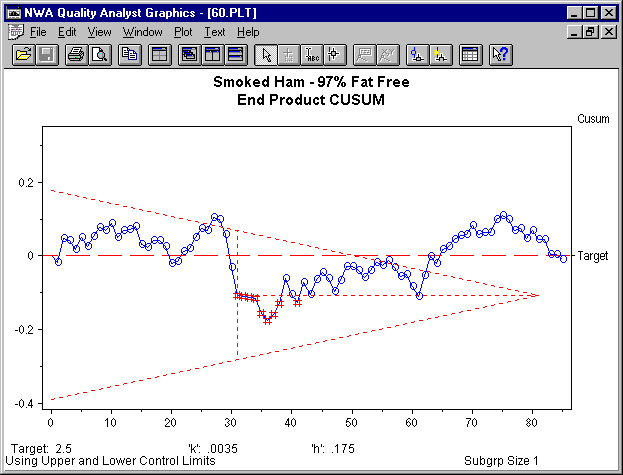 CUSUM produces a control chart based on the accumulated deviations from a target. (See Figure 6.) It is particularly well suited to examining processes that may "drift," and can be tuned to different levels of sensitivity. It is especially useful in regulated industries such as meat and poultry processing. For example, as the USDA added CUSUM methods to inspection procedures such as the Protein Fat-Free (PFF) regulations, NWA adjusted its CUSUM charting routine to match the requirements.
CUSUM produces a control chart based on the accumulated deviations from a target. (See Figure 6.) It is particularly well suited to examining processes that may "drift," and can be tuned to different levels of sensitivity. It is especially useful in regulated industries such as meat and poultry processing. For example, as the USDA added CUSUM methods to inspection procedures such as the Protein Fat-Free (PFF) regulations, NWA adjusted its CUSUM charting routine to match the requirements.
Fill Weight Control
An application-specific method unique to NWA Quality Analyst is the M/I (Median/Individual) chart. This chart solves the special SPC problems presented by "family" processes such as multihead filling machines where the multiple individual processes (the separate fill heads) are combined within a larger process. (See Figure 7.) With conventional control charts, it is virtually impossible to separate the behavior of the individual heads from the global process. To completely monitor a 36-head filling machine, 37 charts would be needed, one per head and one for the overall process.
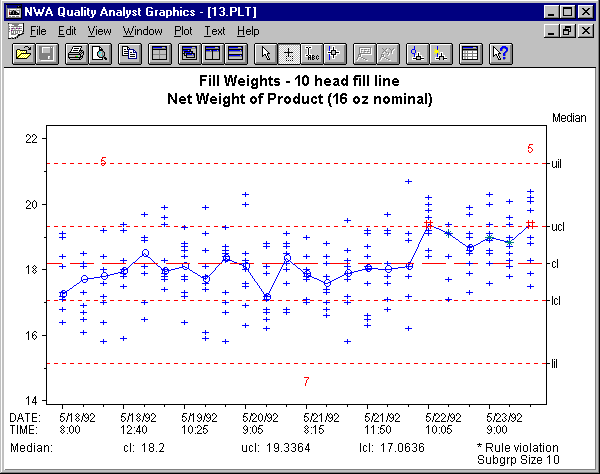 Median/Individuals charts allow users to simultaneously monitor the overall process and the behavior of the individual fill heads. The resulting chart is easy to read and interpret, and far quicker than the alternative. (For an in-depth examination of M/I charting capabilities and applications, see Median/Individual Measurements Control Charting, by Perry Holst and John Vanderveen, developers of the M/I technique.
Median/Individuals charts allow users to simultaneously monitor the overall process and the behavior of the individual fill heads. The resulting chart is easy to read and interpret, and far quicker than the alternative. (For an in-depth examination of M/I charting capabilities and applications, see Median/Individual Measurements Control Charting, by Perry Holst and John Vanderveen, developers of the M/I technique.
SPC in Plantwide Data Systems
Manufacturers and processors across all industries use computer-based information systems to collect and maintain production data. However, data from databases or instruments can be of limited value if the SPC software cannot easily access the data. These obstacles can be overcome if the SPC software can accept data via file transfer (in an open data structure such as delimited ASCII) or if the data source conforms to Microsoft’s ODBC (Open DataBase Connectivity) standard.
Because NWA Quality Analyst makes use of both ASCII file transfer and ODBC, it has become the SPC software of choice for several developers of computer-integrated manufacturing software. What's more, NWA Quality Analyst users can automate redundant or repetitive charting tasks using its macro-like script language. The combination of data access with automation greatly simplifies the task of producing SPC charts and other manufacturing analytics reports wherever and whenever needed.
